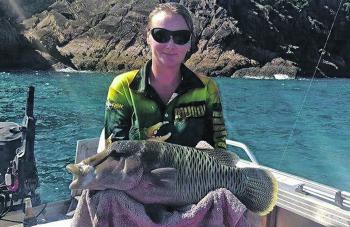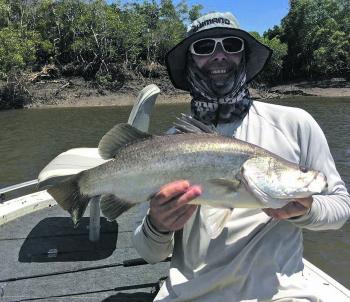Although officially Autumn began on 1 March, our hot, humid wet season really doesn’t start to cool off until April, and of course that change of seasons and conditions heralds in new angling challenges and opportunities.
Barra are still very much on the menu throughout April, despite cooler conditions. There are plenty on the chew both in the saltwater and up in the fresh, whether in our wonderful dams or in the Pioneer River itself. As the month draws to a close, barra will be tougher to catch, particularly in the dams. In past years they have stayed fairly predictable through to June.
As the weather cools off, look for barra in the warmer water on days where the wind drops off. Fish in the saltwater over sand bars on a rising tide. This is a good ploy, as the barra will chase baitfish up into the warmer waters, often with barely enough water to cover their backs. Where there is an old log or other snag up on the sand, that’s a good spot for bait to shelter and for barra to go hunting for a feed. An awesome bait in these situations is live whiting. Any lure/fly that is a reasonable imitation has a good chance of getting hammered.
These spots are ideal for working shallow divers, unweighted plastics or flies on a floating line. Light colours, some flash and slightly darker topsides will all give a good imitation of a small whiting. Plenty of movement when working the lure or fly will mimic the stop-start darting actions of a small whiting and also send out plenty of vibrations for the barra or any other predator to pick up on.
Working lures or baits in these areas will also produce plenty of good size flathead lying in wait for prey. Check out some of these spots at low tide and the flathead lies will be plain to see, and a return on the next high tide should see success for the angler. There’s no need to change lures/baits or tactics if targeting the flatties, as they readily take plastics, vibes, minnows and flies as well as any live or fresh bait they can get in their gob.
Don’t be at all surprised during April and the cooler months to hook into reasonably sized queenfish mooching around the estuaries and creeks. Throw in some smallish trevally and there is variety for the creek angler. These speedsters and the resident tarpon always give a good account of themselves and are great fun to catch even as an incidental by-catch.
The bread and butter species like bream, whiting and estuary cod are all prominent in our creeks and estuaries, with whiting also common along our many beautiful beaches. Beach worms, fresh yabbies, small prawns or slivers of squid will also produce results on these tasty fish.
If fishing the beaches, work the incoming tide and move up with the tide. Most of our beaches are fairly flat with small gutters running through them and with our tidal ranges and flats, there is plenty of walking and fishing to be had. Good places to start for visitors would be the Town and Far beaches and those around Seaforth in the net free zone, and make sure you call into the local tackle stores for the latest info.
Through April the mud crabs should also continue the good run we had during the summer. Although the rains have been patchy, there has been enough in most systems to give them a good flush and get the muddies on the move. Watch the sizes though, as there have been plenty of undersize ones around. For anglers from NSW, remember that females are a no take in Queensland.
As always, the offshore scene will be very weather dependant. On those calm days there has been a lot of reef fish activity. Coral trout around the islands have been going off, with most action being found in shallow water less than 5m deep.
This type of fishing calls for a quiet approach. Roaring up with an outboard and then hurling over an anchor and chain will almost guarantee zero catches. Instead, try either drifting into position or use an electric, and gently lower the anchor over the side to lessen the chances of spooking the fish. A little berley won’t hurt your chances either.
Out in the deeper waters like the shipping channel, there have been great numbers of red fish coming aboard. Red emperor, red throats, large and smallmouth nannies have been the main catches, with the odd Maori wrasse and yellow lippers thrown in for good measure.
The wrasse seem to be increasing in numbers due to the ban on keeping them. That’s good to see. A large wrasse is one very impressive fish and it must be released. Lately there have been reported catches of smaller wrasse at the close in islands, so hopefully juveniles are more common too.
The freshwater scene is also very healthy this month with all three of our dams showing good numbers and sizes of barra. Recently, I heard of two barra from Teemburra Dam going over the 120cm mark. They are impressive fish in anyone’s book. Teemburra also received a boost of 5000 barra between 260 and 300mm during March and Kinchant had a stocking of 2000 similar size barra.
As the water cools off and the winds swing southeasterly, the barra in the dams will be starting to move around looking for comfort zones, which are areas of slightly higher water temperatures. At times they will be right up in the shallows and will look for the baitfish on the windblown side of the dams. The bony bream will be in these areas and the barra won’t be far away.
Recent catches in Eungella Dam have shown numbers of fish over 50cm with the most common size range between 40-50cm. These are impressive sooties and combined with Eungella’s heavy timbered areas, they will present plenty of challenges for anglers.
Sooties are also in good numbers along the rocky foreshores opposite the camping/MAFSA control area and the old quarry walls. These spots are readily accessible for the smallest of boats.
The big news on the freshwater front for April is the running of the Maverick Equipment Hire 12th Annual World Sooty Championship at Eungella Dam from 29-30 April. Nominations opened in March and the tournament is capped at 100 anglers. Anyone wanting to enter should go online ASAP. You can follow links from MAFSA’s Facebook site.
The competition is MAFSA’s major fundraiser and gives away cash and prizes in excess of $10,000 to lucky winners. The money raised from the event is used for purchasing fingerlings for further stocking in the Mackay area.
In the past the competition has attracted anglers from as far afield as Dubbo in NSW and it is renowned as a friendly competition with a very sociable Saturday night. Thanks to Maverick Equipment Hire for again signing on as the major sponsor for the event. Remember to support the businesses that have demonstrated their support for recreational fishing.
At the event, MAFSA will be releasing more fingerlings into the dam, and they will be the last of the 2016/2017 successful breeding season. MAFSA members have already released the first of the estimated 250,000 sooty fingerlings bred in the hatchery into Teemburra Dam and further stockings will be made into Eungella Dam early this month.
Currently, the Mackay area has plenty of options to offer both locals and visitors alike, so why not take advantage of the cooler weather and head up to paradise?
Reads: 2224
Mackay’s dams are thick with barra and Geoff Newby was very pleased with this healthy fish taken slow rolling a black and gold Squidgy out from a small point.

More and more juvenile Maori wrasse like this one Karen Richardson is about to release are showing up around the inshore islands. These fish have to be released, as they are a no take species.

Work a lure near a gully mouth and like Luke Barnes you are likely to catch a lovely saltwater barra. Check out the gully and snag over his shoulder.




